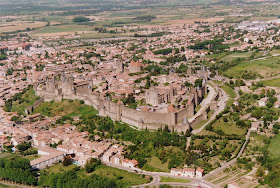Ci-dessous, deux colonies israéliennes dans les territoires occupés de Cisjordanie.


Ci-dessous l'image de deux routes, dont l'une - la plus moderne - est exclusivement réservée aux israéliens.

Ou quand certaines visions, comme The Continuous Enclave : strategies in bypass urbanism, deviennent réalité.
Et pour mieux comprendre ces images, il faut lire l'excellent article Eyal Weizman on writing "Holloow Land", dont je vous propose quelques lignes ci-dessous. Pas forcément nouveau, mais particulièrement juste et pertinent.
"Here the landscape and the built environment are not a panoramic allegory for power relations. This landscape does not only signify or aestheticize power relations, but is the medium of a constituted power. This landscape is not just the site of war, but its very tools.
It is the relation between these two types of transformation – the mediatized punctuating event of spectacular violence – bombing, assassinations, rocket fire, bulldozers (that for most people seem to have appeared from nowhere) – and the more processual and slower events – building, paving, tunneling – not less violent and destructive. The crimes of landscape are less obvious and harder to measure. They require a different order of forensic investigation. But the two types of violence are related and they surely interact.
The spatial conflict over Palestine has re-articulated a certain principle: to be governed the territory must be constantly redesigned. This goes beyond a search for a stable and permanent “governable” colonial form, but rather points to the fact that it is through the constant transformation of space that this process of colonization has played out. Unpredictability and the appearance of anarchy are part of this violent logic of disorder. Violence is a kind of performance that does not take place within the fixed grids of space but actually reshapes it.
The nature of the transformation of the built environment includes the complementary acts of strategic form making: construction and destruction. For example, the recent, massive destruction of homes in Gaza could be understood as the reshaping of the built environment. It was indicative that Israeli politicians were speaking about the how of “reconstruction” in Gaza while ordering the murderous bombing to continue on the people least protected in this world. The furious violence of Israel’s attack left 1,400 people dead and 20,000 buildings, about 15% of all buildings in the Gaza Strip, either fully or partially destroyed."
Pour aller plus loin sur ce sujet, voir "Et si les villes privées et fortifiées devenaient une banalité ?", mais aussi "Et si on s'intéressait à la façon dont les militaires pensent la ville ?" et "Et si l'obsession sécuritaire changeait insidieusement nos rapports à la ville ?"
Voir aussi absolument "Manual de decolonization" (dont les images ci-dessous sont tirées) pour continuer à espérer que le système d'apartheid mis en place par Israël puisse un jour être démantelé.



